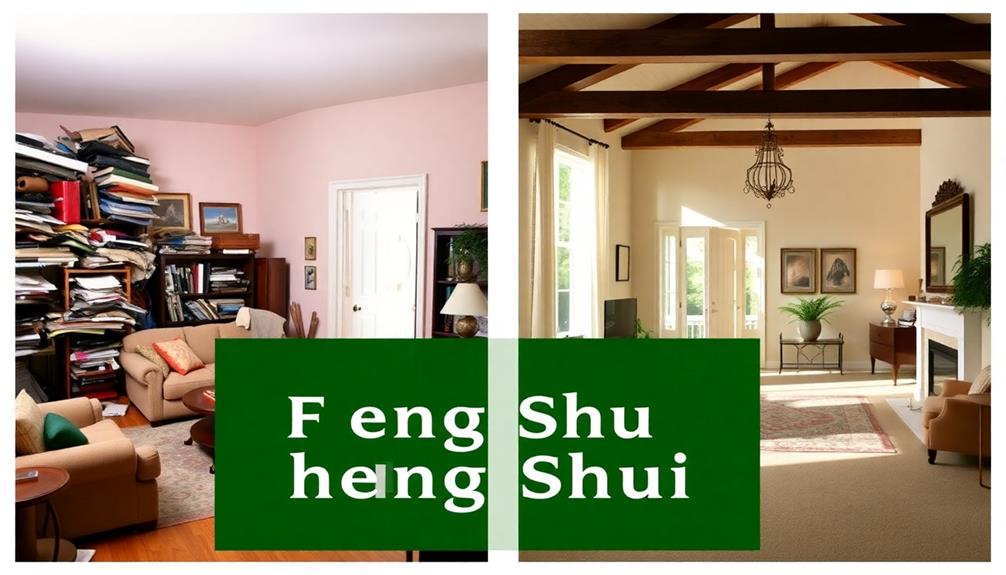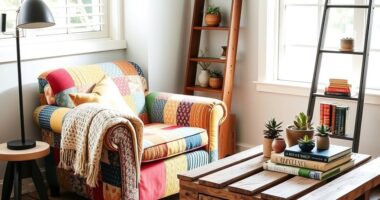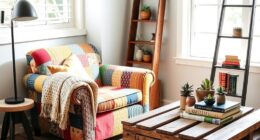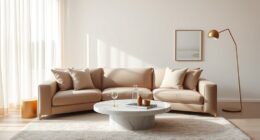You may be committing typical Feng Shui errors that disrupt the flow of energy in your house. Clutter has the potential to block qi and lead to stress, while inadequate lighting could make you feel sluggish. The layout of your furniture might impede smooth movement and create stagnant energy. Furthermore, incorrectly placed mirrors can reflect negativity and disrupt sleep. Remember to take care of your plants; neglecting them represents stagnation. Ultimately, the absence of Feng Shui symbols could impede your goals. By addressing these issues, you can cultivate a more balanced environment. Continue to discover other minor adjustments that can improve the energy in your home.
Key Takeaways
- Clutter obstructs qi flow, leading to low motivation and health issues; regularly declutter your space to enhance positive energy.
- Poor lighting can create lethargy; use multiple light sources and assess quality to improve your home's ambiance.
- Incorrect mirror placement can reflect negative energy; avoid facing mirrors toward the front door or bed for better energy flow.
- Color imbalances can affect mood; choose calming shades for bedrooms and vibrant tones for creativity in kitchens.
- Neglecting plant care can symbolize stagnation; maintain healthy plants to promote good luck and enhance overall well-being.
Clutter and Its Impact
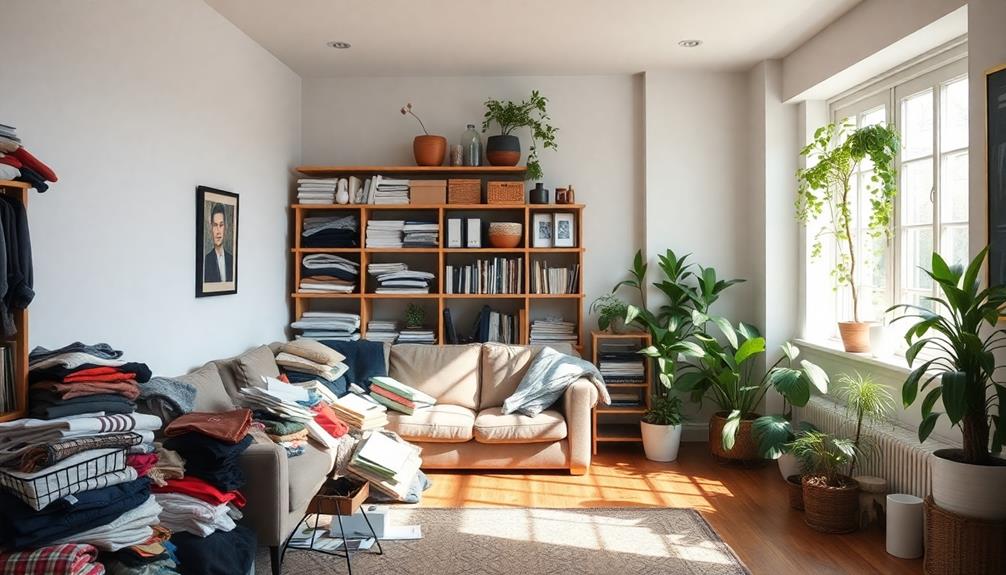
Clutter can easily pile up in your home, and its impact on your life goes beyond just a messy space. In fact, clutter slows the flow of qi, the essential energy that should circulate freely throughout your environment. When this energy flow is blocked, you might experience low motivation, poor health, and even financial struggles.
Incorporating elements of Indonesian decorative pillows can also enhance your space, reflecting cultural heritage while providing comfort. It's important to adhere to Feng Shui rules by regularly clearing tabletops, counters, and corners of unnecessary items.
Start by tidying entry areas—organizing shoes, bags, and coats can greatly enhance energy flow and create a welcoming atmosphere. Using storage solutions like boxes and bins can help manage your belongings and keep closets and cabinets clutter-free.
An immediate decluttering effort can truly energize your living spaces, fostering a sense of relaxation and focus.
Lighting Mistakes
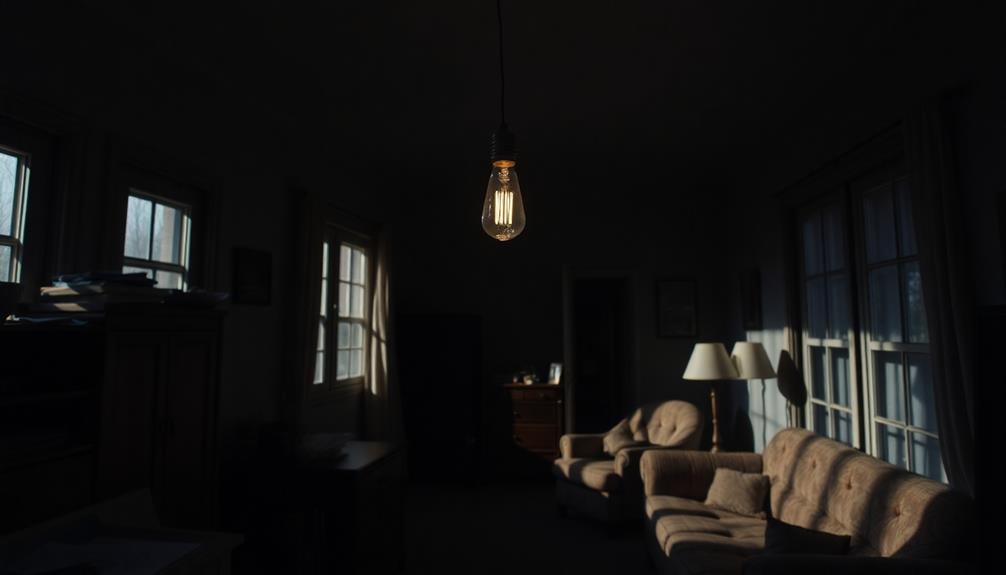
If you've got poor light quality or not enough light sources in your home, it can really dampen the mood and energy of your space.
Creating a well-lit environment is essential for enhancing comfort and promoting a peaceful retreat in your home, similar to the principles of Balinese design characteristics.
You might feel lethargic or uncomfortable without the right lighting setup.
Let's explore how to brighten things up and create a more inviting atmosphere.
Poor Light Quality
Lighting plays a crucial role in your home's energy flow and overall mood. Poor lighting can lead to feelings of lethargy and stress, disrupting the positive energy that should fill your space. Dim or harsh lighting creates an uninviting atmosphere, blocking the natural flow of energy and making your home feel uncomfortable.
To create a more inviting environment, consider incorporating natural materials and vibrant colors that are often found in Bali interior design ideas, as they can enhance the overall ambiance.
To improve your environment, optimize natural light by opening windows and allowing sunlight to flood in. Use multiple light sources, like lamps, to create layers of illumination that promote liveliness, especially in crucial areas like your kitchen and bathroom. Bright, well-distributed lighting in these spaces helps maintain a positive energy flow and prevents energy blockages.
Investing in LED bulbs can also make a significant difference. They not only improve energy efficiency but also brighten your home, fostering a cheerful atmosphere.
Regularly assess and adjust your lighting to guarantee it aligns with the desired energy in your home. By addressing poor lighting, you can create a harmonious living environment that uplifts your spirit and enhances your overall well-being.
Make these adjustments and watch the positive transformation unfold!
Insufficient Light Sources
One common lighting mistake many people make is relying on just a single light source in a room. This often leads to insufficient natural light and can create a dull atmosphere that hinders energy flow.
To boost positive energy in your space, consider incorporating multiple light sources. Using decorative pieces like Indonesian decor masks can also enhance the aesthetic appeal of your room, providing both light reflection and cultural richness. Use a combination of floor lamps, table lamps, and LED fixtures to create a warm, inviting environment.
In areas like kitchens, bright lighting is crucial for enhancing energy and productivity. Conversely, bedrooms benefit from dim lighting that promotes relaxation and calmness.
Don't forget to utilize reflective surfaces, like mirrors, to amplify existing light and brighten those darker corners of your home.
Regularly assess your light fixtures, replacing outdated ones to guarantee they contribute effectively to your space. A well-lit room not only improves your mood but also maintains positive energy throughout your home.
By maximizing daylight through unobstructed windows and using light-colored window treatments, you can further enhance your environment.
Furniture Arrangement Issues
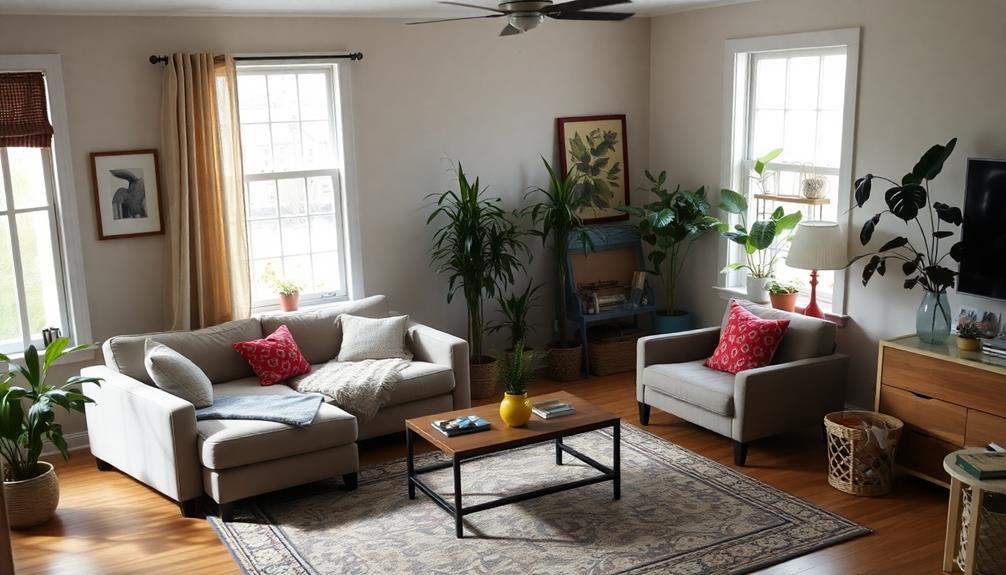
When arranging furniture in your home, don't overlook the impact it has on the flow of energy, or qi. Incorporating unique elements, such as Indonesian decor masks, can also enhance the energy in your space.
Poor furniture arrangement can block pathways, leading to discomfort and chaos. Here are some common Feng Shui mistakes to avoid:
- Block pathways: Confirm furniture doesn't obstruct movement, allowing energy to flow freely.
- Size matters: Measure your space before buying new furniture. Oversized or undersized pieces can disrupt balance and harmony.
- Avoid corners: Placing furniture in corners can cause stagnant energy. Opt for open arrangements that encourage movement and accessibility.
- Room function: Think about the purpose of each room. For instance, position a desk to minimize distractions, enhancing focus.
Mirror Placement Errors
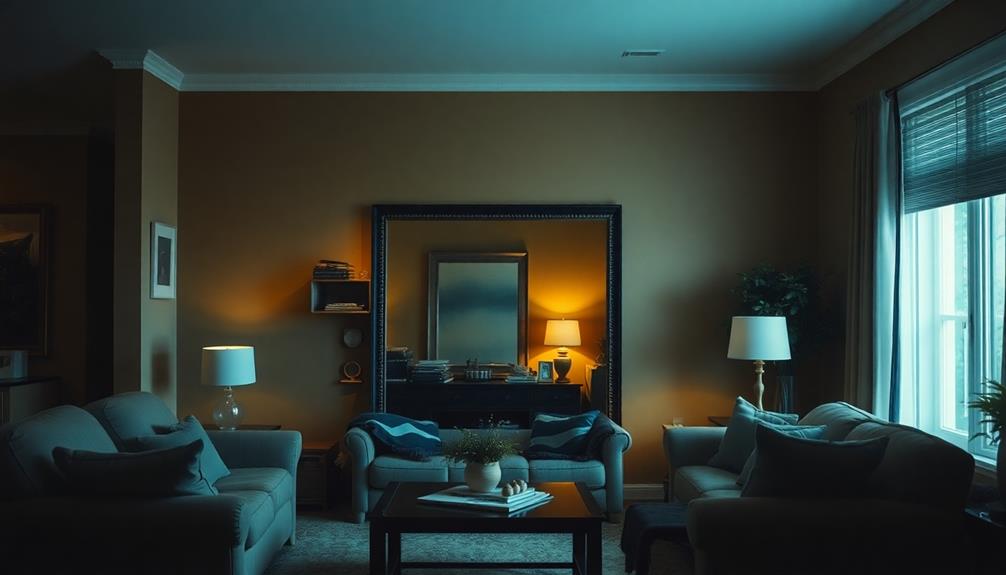
When it comes to mirrors, placement is everything. You mightn't realize that mirrors facing the front door can bounce positive energy right back outside, while those opposite your bed can disrupt your sleep.
To create a harmonious atmosphere in your home, consider incorporating elements like vibrant color palettes and traditional motifs, which can enhance the overall energy of your space, similar to how you'd approach Indonesian wedding decor ideas.
An overabundance of mirrors can also create a chaotic environment, so it's important to be mindful of how and where you use them.
Reflecting Negative Energy
Misplaced mirrors can create an unsettling atmosphere in your home, reflecting negative energy instead of enhancing it. When you position mirrors incorrectly, they might bounce energy away from essential spaces, leading to missed opportunities and a lack of abundance.
For instance, placing a mirror directly opposite the front door sends positive energy right back outside, preventing it from entering your home. In traditional Indonesian housing, the layout and placement of elements are often designed with spiritual significance and energy flow in mind, which can serve as a reminder for us to be mindful of our own spaces traditional Indonesian housing.
Here are some common mirror placement errors to avoid:
- Mirrors facing the bed: They can disrupt your sleep by reflecting energy away from your resting space.
- Excessive mirrors in one area: Too many mirrors can create a sense of unease and imbalance, leading to restlessness.
- Mirrors opposite the front door: They reflect good energy outside, hindering the flow of abundance into your life.
- Ignoring side placements: Positioning mirrors to the side of the entryway allows energy to enter smoothly while still enhancing light and space.
If relocating mirrors isn't feasible, consider swapping them out for uplifting artwork to maintain a positive energy flow and create a more harmonious environment.
Misplaced Mirrors in Entryways
Many homeowners underestimate the impact of mirror placement in entryways, yet it can considerably influence the energy flow in your space. Misplaced mirrors can create significant Feng Shui mistakes, reflecting positive energy back outside when positioned directly opposite the front door. This not only disrupts the flow of good qi but can also lead to feelings of unease and imbalance in your home.
To enhance your entryway's energy flow, consider these placement strategies:
| What to Avoid | Better Alternatives |
|---|---|
| Mirrors facing the front door | Mirrors placed to the side |
| Excessive mirrors creating chaos | Artwork that fosters warmth |
| Blocking natural light and energy | Strategically placed mirrors for light amplification |
When relocating mirrors isn't possible, replacing them with welcoming artwork can help maintain a positive atmosphere. Remember, strategically placed mirrors can amplify natural light and create a more inviting space, so pay attention to their placement to avoid these common Feng Shui mistakes. Your entryway sets the tone for your entire home—make it a welcoming one!
Overabundance of Reflective Surfaces
An overabundance of reflective surfaces can create chaos in your home's energy flow. While mirrors can enhance light and space, too many can disrupt the balance, leaving you feeling uneasy or anxious.
It's important to be mindful of where you place mirrors to avoid common Feng Shui mistakes. For instance, incorporating sustainable practices in your interior design can also contribute to a more harmonious environment, as seen in expert tropical design.
Consider these tips to optimize your mirror placement:
- Don't position mirrors directly opposite the front door; they can push away positive energy entering your home.
- Limit the number of mirrors in any room to maintain harmony and enhance energy flow.
- Avoid placing mirrors facing the bed, as this can disturb your sleep quality and affect personal relationships.
- Strategically place mirrors to reflect natural light or a beautiful view without overwhelming the space.
Entryway Oversights
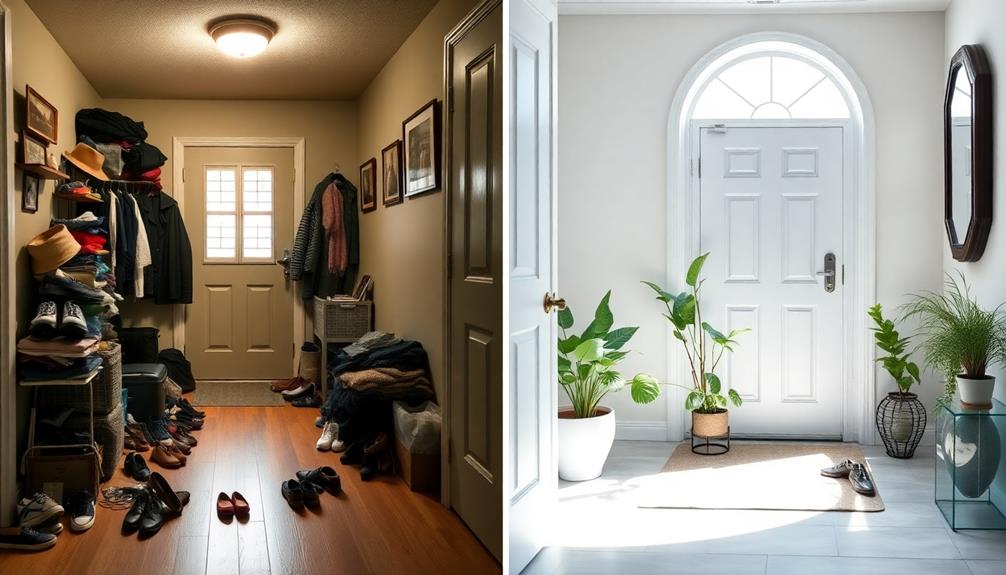
Right at the start of your home, the entryway sets the tone for the energy that flows within. If it's cluttered, you're blocking positive energy and creating a negative first impression for visitors. Keep your entryway clutter-free to promote a smooth energy flow. Clear pathways are essential; make certain nothing obstructs the way.
Adding decorative elements can enhance your entryway's atmosphere. Consider welcoming artwork or plants that invite good energy. Regular maintenance, including cleaning and organizing, keeps this space inviting and impactful.
Be mindful of mirror placement, too. If you have mirrors directly opposite the front door, they can push away positive energy. Instead, position them to the side for better energy reception.
Here's a quick overview of entryway tips:
| Common Oversights | Solutions |
|---|---|
| Clutter accumulation | Maintain a clutter-free space |
| Obstructed pathways | Guarantee clear pathways |
| Uninviting decor | Use welcoming artwork/flowers |
| Neglecting maintenance | Regularly clean and organize |
| Mirrors facing the door | Position mirrors to the side |
Color Imbalance
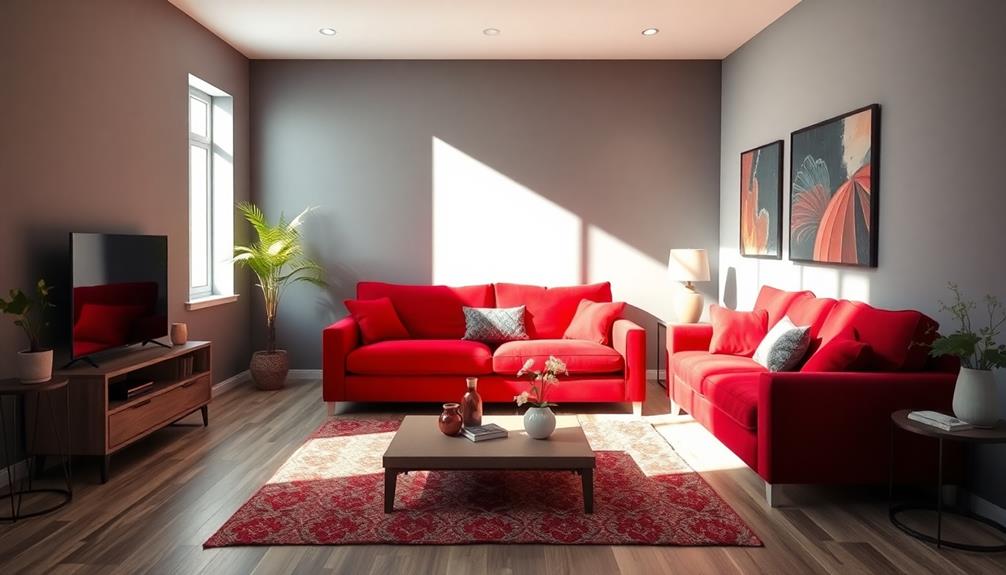
When it comes to color in your home, balance is key to creating a harmonious atmosphere.
Incorporating a neutral color palette can help create a tranquil space that complements vibrant tropical hues without overwhelming your senses.
Too many bright colors can overwhelm your senses, while excessive dark hues might leave you feeling heavy and down.
Understanding color psychology can help you select the right shades to enhance your mood and energy.
Color Psychology Impacts Mood
Often, the colors you choose for your home can greatly influence your mood and overall well-being. Understanding color psychology is essential for creating a space that promotes good feng shui and positive energy flow.
Different colors evoke specific emotions, so it's important to select hues that align with the purpose of each room. For instance, incorporating natural materials and lush greenery, as seen in modern tropical aesthetics, can enhance the calming effect of your color choices.
Consider these tips to optimize your color choices:
- Use calming colors like blue or green in bedrooms to encourage relaxation.
- Incorporate vibrant tones like yellow or orange in kitchens to stimulate activity and creativity.
- Avoid heavy or dark colors in living spaces, as they can create an oppressive atmosphere, leading to stress and anxiety.
- Maintain a cohesive color palette to prevent clashing colors, which disrupts energy flow (qi) and creates visual chaos.
Balance and Harmony Essentials
Achieving balance and harmony in your home hinges on the thoughtful selection of colors. Your color choices greatly impact the mood and energy of your space. Overly dark colors can create a heavy, oppressive atmosphere, while excessively bright hues may disrupt the tranquility you seek.
To foster a vibrant and balanced environment, opt for a well-rounded color palette that promotes harmony and avoids the stress associated with monochromatic designs.
In Feng Shui, each color embodies different elements and energies, so choosing wisely can enhance the ambiance you desire. Neutral tones are particularly effective for promoting balance and calmness, making them ideal for relaxation spaces. They allow for versatility and can be complemented with pops of color to maintain interest without overwhelming your senses.
It's essential to strike a balance; too many bright or saturated colors can lead to chaos in your environment, hindering relaxation and affecting your well-being.
Avoiding Overwhelming Brightness
Incorporating bright colors can energize a space, but too much brightness can easily overwhelm your senses and create a chaotic atmosphere. Excessive brightness may lead to feelings of anxiety and stress.
To cultivate tranquility and harmony, you should focus on using a balanced color palette that incorporates softer tones and neutrals.
Consider the following tips:
- Choose lighter shades, like pastels, to promote calmness.
- Mix vibrant colors with softer hues to avoid overwhelming brightness.
- Regularly reassess your color choices to maintain a serene environment.
- Create a cohesive color scheme to prevent visual chaos.
Neglecting Plant Care

Neglecting plant care can drain the energy in your home, as unhealthy or dead plants symbolize stagnation and negativity. When you overlook the needs of your indoor plants, you invite an atmosphere that feels heavy and uninspired.
Regular maintenance, like watering and pruning, is essential for enhancing air quality and liveliness. Healthy plants contribute to a positive energy flow, making your space feel more inviting and alive.
Choose plants that thrive in your environment, such as bamboo or peace lilies, to promote strength, good luck, and overall well-being. It's important to remove dead plants promptly, as they disrupt the harmonious energy necessary for personal growth and tranquility.
Healthy plants not only beautify your space but also act as living symbols of abundance and prosperity. By actively caring for your greenery, you're reinforcing good energy in your home.
So, take a moment to evaluate your plants; are they thriving or wilting? If they need attention, give it to them, and watch as your living environment transforms into a sanctuary filled with positive vibes.
Don't underestimate the impact of neglecting plant care on your home's energy!
Missing Feng Shui Symbols
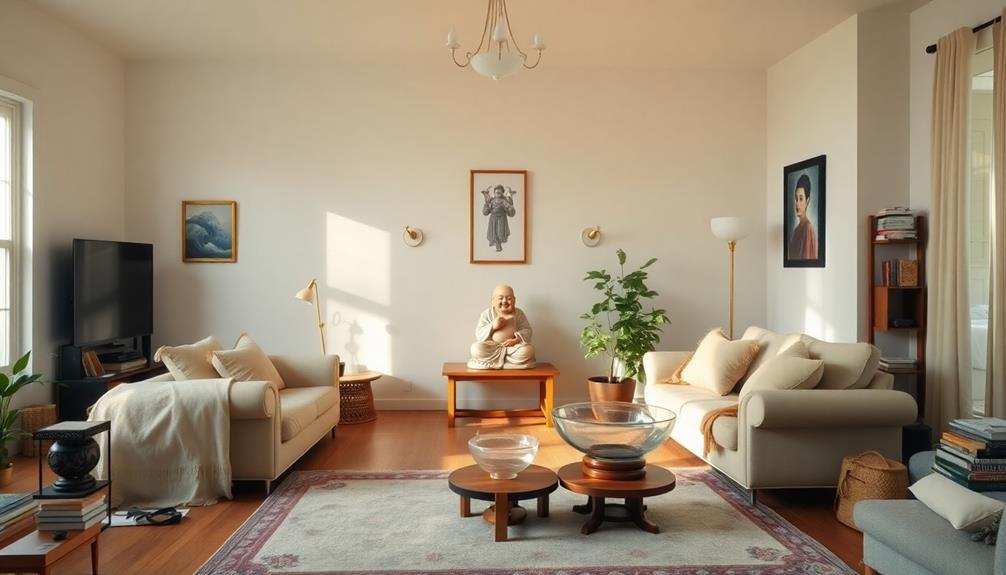
Without the right Feng Shui symbols, your home may lack the vibrant energy needed to support your goals and aspirations. Missing these intentional symbols can hinder the flow of positive energy and affect various aspects of your life, including wealth and health.
To enhance your environment, strategically place symbols that resonate with your personal intentions.
Consider incorporating the following Feng Shui symbols into your space:
- Dragons: Represent strength and protection.
- Wind Chimes: Promote harmony and tranquility.
- Feng Shui Coins: Attract financial flow and abundance.
- Crystals: Amplify positive energy and clarity.
Make sure to focus on the wealth corner of your home by placing Feng Shui coins there, as they reinforce the connection between your environment and prosperity.
Regularly evaluating and revitalizing these symbols keeps your home aligned with your evolving goals, enhancing feelings of happiness and luck.
By incorporating meaningful symbols that reflect your personal values and aspirations, you can greatly influence the energy and ambiance of your living space.
Don't underestimate the impact of missing Feng Shui symbols; they can truly transform your home's vibe. In fact, placing certain objects in the wrong areas or neglecting key elements can disrupt the flow of positive energy, creating an imbalance in your space. Some common feng shui mistakes to avoid include cluttered entryways, incorrect mirror placement, and neglecting to activate key zones like the wealth or health corners. By addressing these, you can experience a noticeable shift in harmony and overall well-being within your home.
Bed Placement Problems
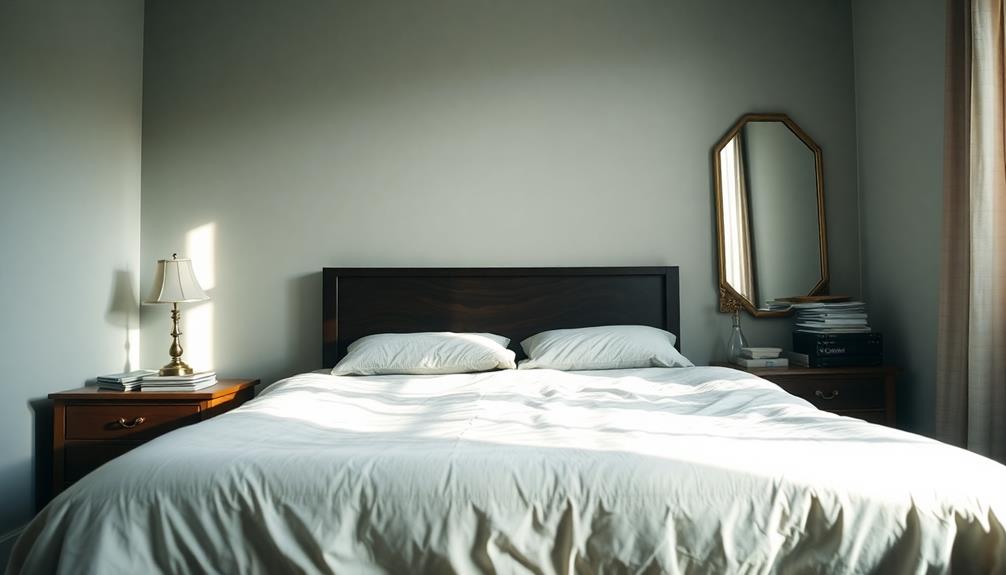
Getting your bed placement right is essential for creating a harmonious bedroom that supports restful sleep and revitalizes your energy.
Avoid placing your bed directly on the same wall as the door. This position can disrupt energy flow, leading to a restless night. Instead, position your bed where you can see the door while lying down, which enhances your sense of security and gives you a commanding view of the room's energy.
Also, steer clear of placing your bed under a window. This setup can make you feel vulnerable, negatively affecting your sleep quality. If adjusting your bed placement isn't possible, consider using mirrors to reflect the door, helping maintain a connection to the room's energy.
Lastly, make certain the space under your bed is clear of clutter. A clean area promotes ideal energy circulation, supporting relaxation and rejuvenation.
Kitchen and Bathroom Feng Shui
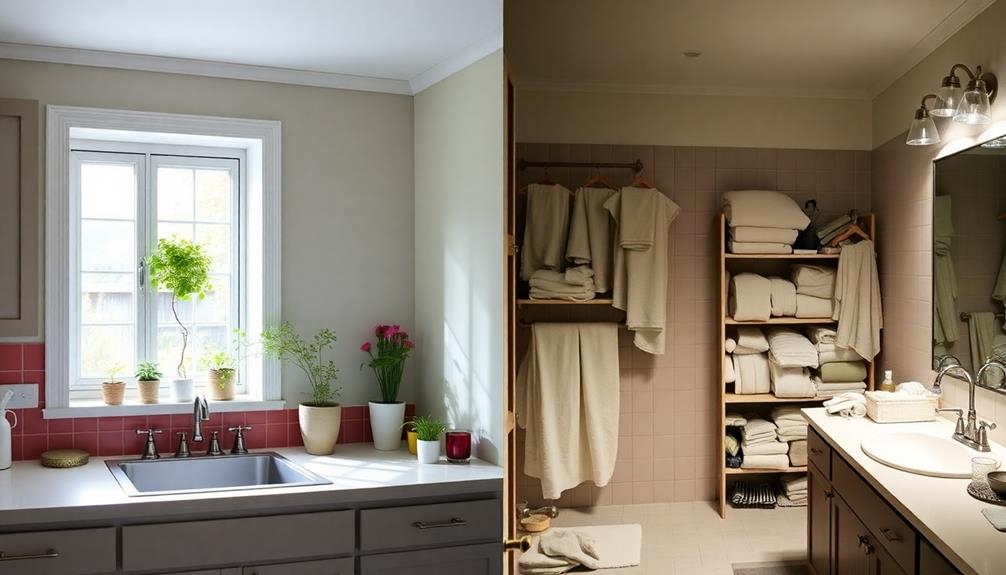
A well-organized kitchen and bathroom can greatly enhance the positive energy in your home. By focusing on cleanliness and order, you can improve the energy flow in these crucial spaces.
Start by regularly disposing of expired food in your kitchen to foster abundance and prosperity. Bright lighting in your kitchen is essential for promoting cheerfulness, while your bathroom should also be well-lit to prevent energy blockages.
To maintain the best energy flow, keep these tips in mind:
- Always close the toilet lid to prevent draining good fortune.
- Keep bathroom doors closed to maintain a clutter-free environment.
- Store items neatly in both spaces to avoid chaos.
- Regularly clean and organize to support overall health and well-being.
Frequently Asked Questions
What Is Considered Bad Feng Shui in a House?
Bad feng shui in a house includes poor door conditions, clutter accumulation, misplaced mirrors, unbalanced furniture, and improper bed placement. You should address these issues to enhance energy flow and create a more harmonious living environment. Feng shui mistakes in design can also include obstructed pathways or harsh lighting, which disrupt the natural movement of energy throughout the space. It’s important to ensure that rooms are well-lit and free of obstacles to promote positive chi and create a tranquil atmosphere in the home. By correcting these design errors, you can foster a more balanced and peaceful living space.
What Colors Should Be Avoided in Feng Shui?
Colors can act like a symphony; too many dissonant notes create chaos. In feng shui, avoid excessively dark hues, overly bright shades, and heavy monochromatics, as they disrupt balance and may lead to emotional turmoil.
What Are the Designs to Avoid According to Feng Shui?
In feng shui, avoid placing mirrors opposite your front door, overcrowding spaces with furniture, using heavy colors, aligning your bed with the door, and having too many potted plants in bedrooms to promote positive energy.
What Are the Feng Shui Rules for a House?
To enhance your home's energy flow, guarantee your front door's clear and in good repair. Position your bed for a commanding view, maintain a clutter-free entryway, and use light colors for a tranquil atmosphere.
Conclusion
Don't let these common feng shui mistakes hold you back from creating a harmonious home. By tackling clutter, adjusting your lighting, and being mindful of furniture arrangements, you can enhance the positive energy in your space. Have you ever considered how the placement of mirrors and plants can transform your environment? With a few simple tweaks, you can invite balance and tranquility into your life, making your home a true sanctuary. Start today and feel the difference!
